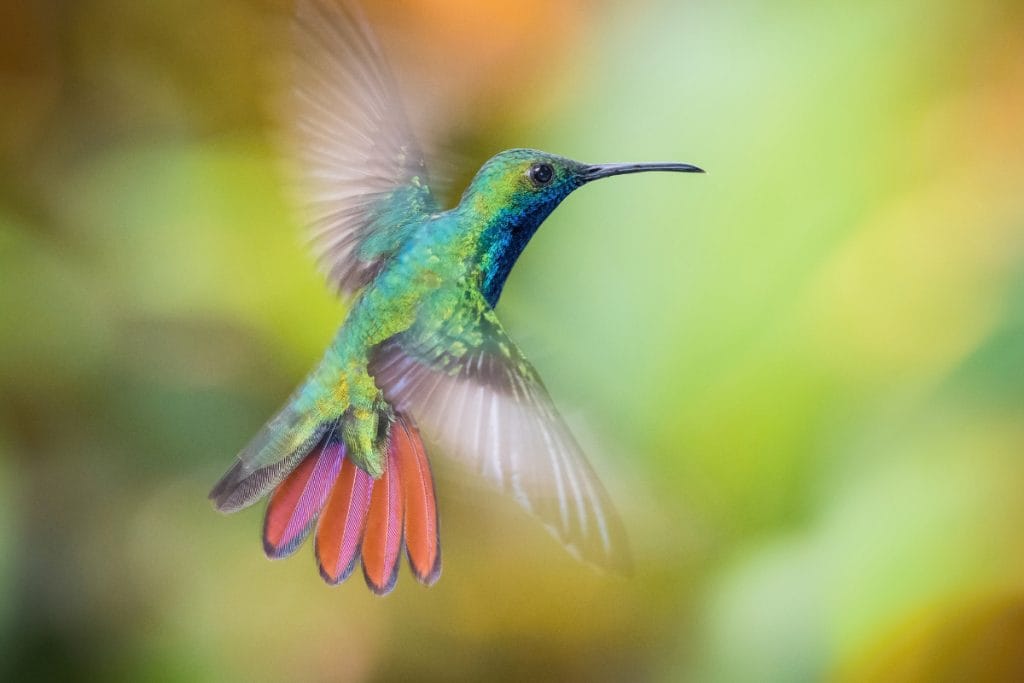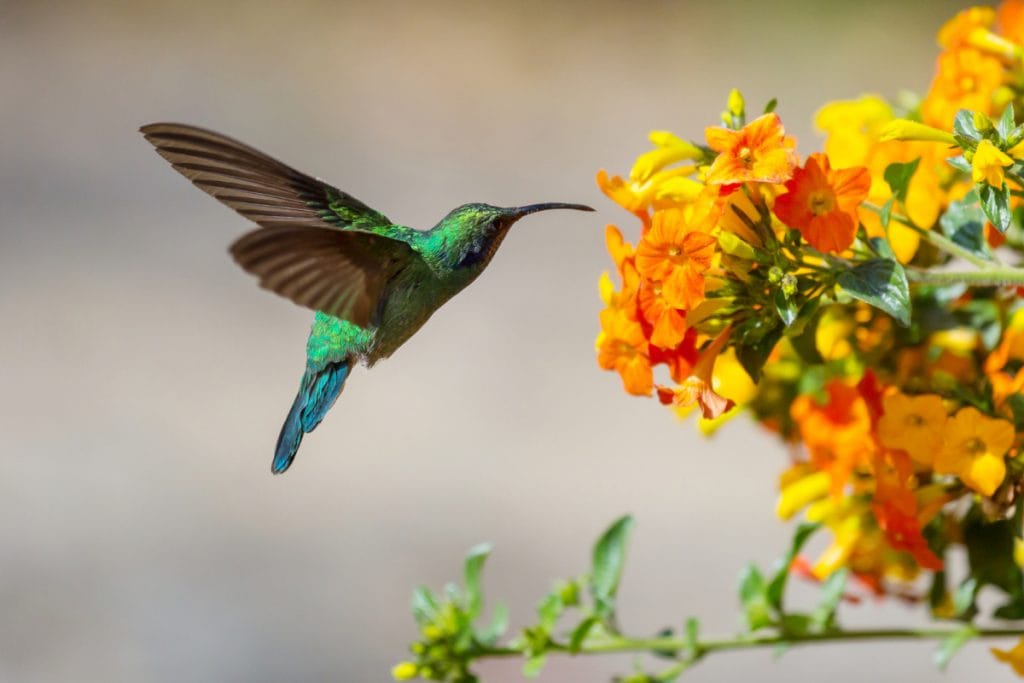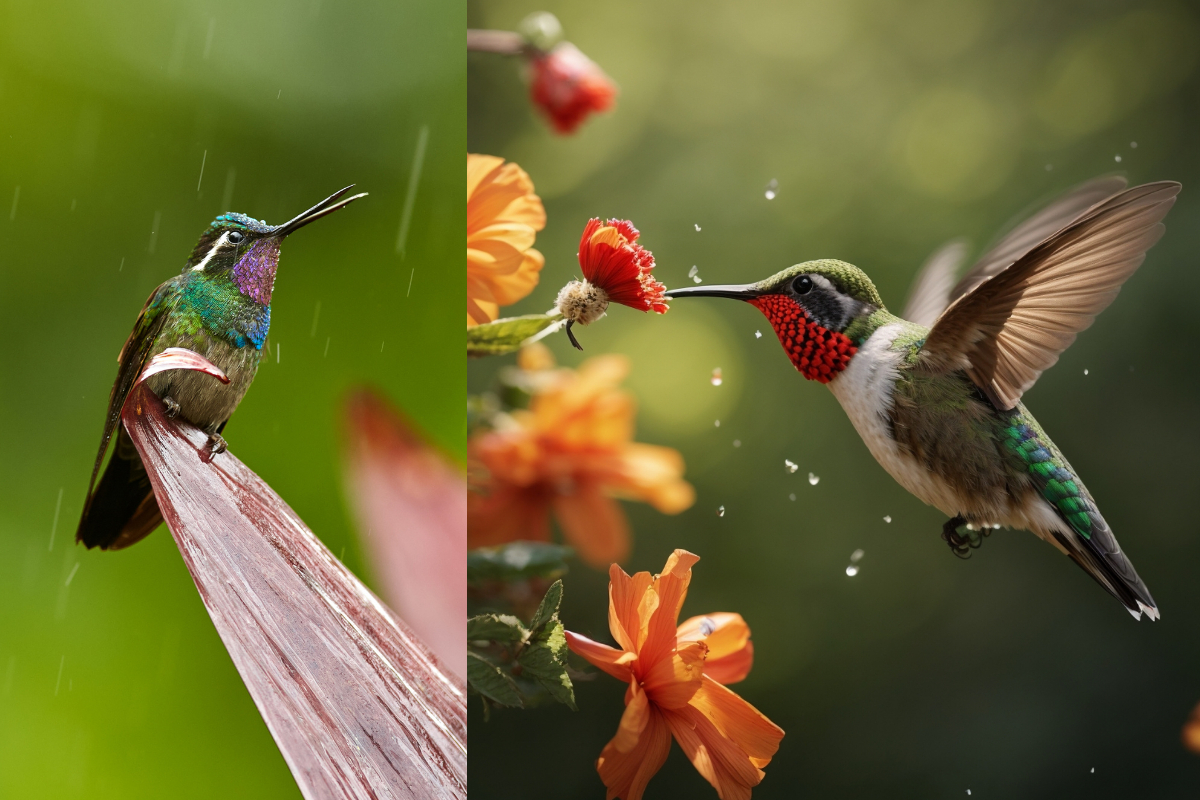Hummingbirds are some of the smallest and most remarkable birds in the world. Their tiny sizes and incredible flying abilities make them a delight to watch. But just how small are hummingbirds? And how do they manage to hover and fly backwards on those tiny wings?
In this blog post, we will uncover 6 fascinating facts about hummingbird sizes that will give you a new appreciation for these tiny, beautiful birds.
Key Takeaways
- Hummingbird Comparative Size: The bee hummingbird is the world’s smallest bird, measuring just 2 inches from bill to tail, about the size of a large bumblebee. On average, hummingbirds are between 3 to 5 inches in length, making them about 1/5 the size of common backyard birds.
- Reason for Small Size: The tiny size of hummingbirds is an evolutionary adaptation to their diet of sugary nectar. Their lightweight bodies allow them to have fast heart rates and metabolisms, which are essential for their hovering flight. Their petite size also lets them access nectar from flowers that other animals cannot.
- Wing Size and Function: Despite their small body size, hummingbirds have relatively long wings, allowing them to beat up to 200 times per second. This unique wing structure grants them specialised flight abilities, including hovering and flying backwards.
- Variation Among Species: There are over 350 species of hummingbirds with varying sizes. While the bee hummingbird is the smallest, weighing around 2 grams, the giant hummingbird of South America is the largest, weighing up to 20 grams. Most hummingbird species, however, weigh between 2 to 6 grams.
Related post to read about Best Hummingbird Feeders
- Key Takeaways
- 1. How Small Are Hummingbirds Compared to Other Birds?
- 2. Why Are Hummingbirds So Small?
- 3. How Does Wing Size Relate to Their Tininess?
- 4. Do Male and Female Hummingbirds Differ in Size?
- 5. How Does a Hummingbird's Weight Compare to Other Objects?
- 6. Do Hummingbird Species Vary in Size?
- The Bottom Line
- Useful Links:

1. How Small Are Hummingbirds Compared to Other Birds?
Hummingbirds are the smallest birds in the world. The bee hummingbird, found in Cuba, is the smallest at just 2 inches long from bill to tail feathers. To put that into perspective, a bee hummingbird is about the size of a large bumblebee!
Most hummingbirds are larger than the bee hummingbird but still remarkably tiny compared to other birds. The average hummingbird length is 3 to 5 inches. Sparrows, in comparison, are typically 6 to 7 inches, while crows can be up to 2 feet long.
So, a hummingbird is usually about 1/5 the size of a more common backyard bird. Their lightweight bodies allow them to hover effortlessly as they drink nectar from flowers.
2. Why Are Hummingbirds So Small?
Hummingbirds’ diminutive size is an adaptation that allows them to survive on their unique diet of sugary nectar.
Here’s why their small size is perfectly suited for nectar-feeding:
- High metabolisms: Hummingbirds have incredibly fast heart rates and metabolisms to power their wings during hovering flight. Their bodies need huge amounts of energy. The fast heart rate requires a lightweight body that a larger bird couldn’t sustain.
- Less energy needed: The smaller a bird is, the less energy it takes to power flight. Their small bodies allow them to thrive on the limited calories in nectar. Larger birds would quickly starve.
- Fits flower shapes: Hummingbirds have slender beaks and long tongues that are specially designed to reach the nectar at the base of long, tubular flowers where bees and other insects can’t reach. Their tiny size allows them to access nectar that other animals can’t.
So you can think of their petite proportions as perfectly adapted to their high-energy lifestyle and unique food source!

3. How Does Wing Size Relate to Their Tininess?
Given their extremely small bodies, you might assume hummingbird wings are also tiny. But they’re actually relatively large for the bird’s overall size.
The long, narrow wings of hummingbirds allow them to beat up to 200 times per second, enabling specialised flight abilities like hovering and flying backwards.
To visualise the difference, imagine a hummingbird skeleton next to a pigeon skeleton. The hummingbird bones would all be miniature versions, but the wing spans would be almost identical.
So, while the overall body size is tiny, the wing length is long relative to the body, making up around 1/3 of their total length. This allows them to generate the lift and power they need for specialised flight techniques that other birds can’t accomplish.
4. Do Male and Female Hummingbirds Differ in Size?
There is some size difference between male and female hummingbirds. Males tend to be slightly larger, which is unusual among bird species.
In most bird types, females are larger. But in hummingbirds, males maybe 5-10% bigger than females. They use aerial displays during mating dances to show off for potential mates, so a larger size with bigger, brighter feathers can give them a competitive edge.
The size difference is most pronounced during the breeding season when males are actively courting females. At other times, it may be hard to distinguish based on size alone.
So, while the size difference is minimal, if you see two hummingbirds chasing each other around your yard, the slightly bigger one is likely the male!

5. How Does a Hummingbird’s Weight Compare to Other Objects?
Hummingbirds weigh so little it’s hard to wrap your brain around it. The average weight is about the same as two to three US pennies.
Here are some other everyday objects that weigh about the same as a hummingbird, between 2 to 6 grams: A single metal paperclip, A penny and an AA battery.
So they’re thousands of times lighter than humans. Their lightweight allows them to achieve feats of flight that would be otherwise impossible for larger birds!
6. Do Hummingbird Species Vary in Size?
There are over 350 species of hummingbirds that vary slightly in size. The smallest is the bee hummingbird, which weighs around 2 grams. The largest hummingbird species is the giant hummingbird of South America.
At up to 8.5 inches and 20 grams, giant hummingbirds are double the size of bee hummingbirds. They’re the only hummingbirds able to perch on branches without a hover.
Other large species include the white-necked jacobin of Brazil at 11 grams and the long-billed starthroat of Mexico at over 12 grams.
While giant hummingbird species definitely stand out, most hummingbirds only range between 2 to 6 grams, no matter the species. So, aside from a few outliers, they maintain a consistently tiny stature across different types.
The Bottom Line
For their tiny stature, hummingbirds have astonishing flight skills and enormous appetites. Evolution has honed them into perfectly petite nectar-feeding machines.
Their minuscule size places them in an exclusive bird family full of cute and remarkable characteristics. While they may be small, hummingbirds certainly make a big impression.
I hope you enjoyed learning about why hummingbirds are so tiny but mighty. Their diminutive proportions allow them to survive and thrive like no other bird. Next time you see a hummingbird buzzing by, take a moment to appreciate these captivating little birds. Thanks for reading!
Useful Links:
Related Posts to Read:
- Best Hummingbird Feeders.
- Do Hummingbirds Beaks Open When Feeding?
- The Mysteries of Hummingbird Flight.
Related Posts to Read – Hummingbirds Migrations:
- When Do Hummingbirds Leave Ohio?
- When Do Hummingbirds Leave Michigan?
- When Do Hummingbirds Leave Pennsylvania?
- When Do Hummingbirds Leave Florida?
- When Do Hummingbirds Leave Oregon?
- When Do Hummingbirds Leave New York?
- When Do Hummingbirds Leave Kansas City?
- When Do Hummingbirds Leave Oklahoma?
References:
- About Hummingbird (Wikipedia).
- Greenewalt, C. H. (1960). Hummingbirds. New York: Doubleday. Google Scholar.
- Carey C. The impacts of climate change on the annual cycles of birds. Philos Trans R Soc Lond B Biol Sci. 2009 Nov 27; 364(1534):3321-30. doi: 10.1098/rstb.2009.0182. PMID: 19833644; PMCID: PMC2781852.
- Rico-Guevara A, Rubega MA, Hurme KJ, Dudley R. Shifting Paradigms in the Mechanics of Nectar Extraction and Hummingbird Bill Morphology. Integr Org Biol. 2019 Jan 2;1(1):oby006. doi: 10.1093/iob/oby006. PMID: 33791513; PMCID: PMC7671138.
